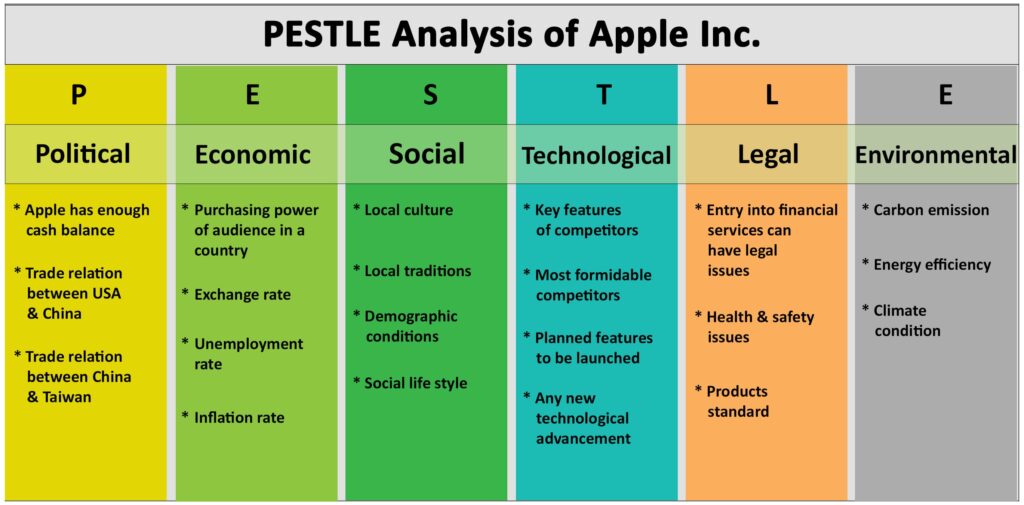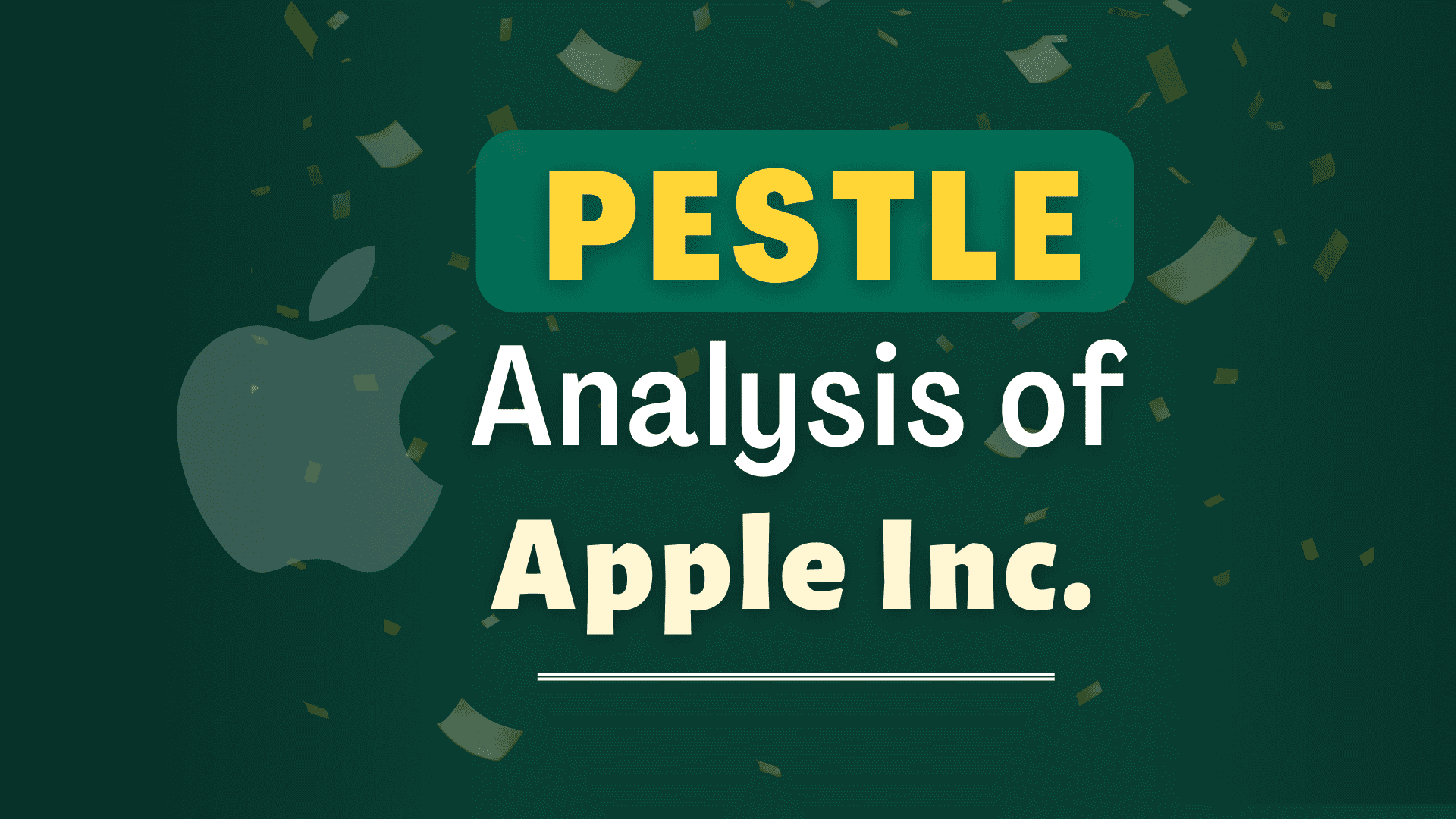Apple Inc. is one of the biggest consumer electronics brands in the world. Headquartered in America, it deals in smartphones, personal computers, software, tablets, computer peripherals, etc.
It holds a 15.6% market share in its industry with a total market capitalization of 2.2 trillion USD. As of 2019 statistics, over 45% of Americans use an Apple iPhone.
PESTLE Analysis of Apple
This article presents a PESTLE analysis of Apple Inc. to assess its success over the last decades.
Apple Inc.’s Background
Steve Jobs and Steve Wozniak founded Apple Inc. on 1st April 1976 as college dropouts. The vision was to change how individuals viewed computers. They formed the company to make small, light, and handy computers.
Apple’s vision is to bring the best user experience to its customers through innovative software, hardware, and services.
The Range of Apple Products
Apple offers the following products: MacBook, iPhone, iPad, Apple TV, AirPods, Apple Watch, HomePod, and related accessories.
Over the last decade, Apple’s revenue has tripled from $108 billion to $365 billion. The iPhones alone generate 50% of its revenue. The success behind Apple’s tremendous growth was due to its strategic vision focusing on enhancing the performance and designs of its products every passing year.
Questions to be Asked in the Apple’s PESTLE Analysis
1- Who are the company’s stakeholders?
2- Is there going to be a state election in the US soon?
3- Can a change in the government change Apple’s policies?
4- Are there any pending taxes or regulations affecting Apple’s business?
5- What budget does Apple operate at?
6- What is Apple’s performance over the years?
7- Is Apple involved in any CSR activities?
8- How is the employee environment in the company?
9- Has the demand for Apple products increased, decreased, or remained the same over the last few years?
10- Are any lifestyle choices, cultures, or religious beliefs going to impact Apple’s business?
11- How is society socially changing?
12- Does a generation shift affect the business?
13- What technology does the company use?
14- Is the technology up to date?
15- Do the competitors use a similar or better technology?
16- How is the company staying true to its objectives?
17- Are there any ESG activities Apple can participate in or is participating in?
18- How does the business source, test, and trade its products?
19- Is Apple, an ethically sound company?
20- Does it consider the consumer’s satisfaction as a priority?
Conducting Apple Inc.’s PESTLE Analysis
Political Factors
Political factors include the country where a business operates, including relationships between the home and foreign countries. The type of political factors affecting the PESTLE analysis includes tax laws, government levies, political stabilities, policies, etc.
Apple Inc.’s external environment is affected by political factors as the business operates in a government-defined environment.
Here is how the political environment affects Apple’s business:
- Political stability in most countries where they sell Apple products presents several opportunities.
- Improved trade policies between America and other countries also create business opportunities.
- The US-China trade war has affected business negatively. For example, it leads to a reduced market share of Apple products in the Chinese market.
- Since the US government increased taxes on Chinese imports, the taxes on Apple products also increased and decreased the supply of Apple products in China.
- Apple Inc. had to pay $15 million during a dispute with the Ireland government, facing a reduction in profitability.
- India is the third biggest market for Apple and has a favorable bureaucracy and trade relations. This contributed to Apple’s success in the Indian market.
- Since Apple depends on low-cost manufacturing in China, political unrest causes negative impacts on the business.
- The cost of finding an alternative to the Chinese market (due to the US-Chinese trade war) is not easy for Apple.
Economic Factors
Economic factors refer to the factors that affect the economy of the business. So, economic growth, inflation, interest rates, unemployment, and exchange rates are common economic factors.
Apple analyses economic factors in building strategies to help businesses function during economic change. Such methods include enhancing sales campaigns due to consumers’ anticipated higher purchasing power to improve the company’s economic performance.
Here is how the economic environment affects Apple’s business:
- The rapid growth and development in developing countries affect the business positively.
- Economically sound and stable companies enable Apple to increase its business.
- The fast-moving economic growth and GDP levels in Asian countries make it easy for Apple to penetrate deep into Asian markets.
- Recently, labor costs in several countries manufacturing Apple products have increased, negatively impacting the business’s profitability.
- An appreciating US dollar against Asian currencies makes it tough for Apple to do business in its third-largest market.
- Apple’s premium-pricing strategy makes it challenging to increase sales in the low to the medium-income population in Asian countries.
- The global recession after the pandemic has somewhat impacted Apple’s sales.
Social Factors
Social Factors refer to the mindset of a country. It includes cultures, traditions, and beliefs that affect the sales of a business. Apple consistently studies the social lifestyle, cultural implications, gender norms, and demographics to help the business understand the market they are operating. It also assists them in marketing their products better to different societies.
For example, in traditional markets like India and China, Apple advertises through television and newspaper. In addition, it targets consumers during festivals like Diwali and the Chinese New Year.
Here is how the social environment affects Apple’s business:
- The increasing tension behind US-China is also creating a tiff between the people of the two countries. Having close connections with either of the markets may offend the other.
- Urbanization is increasing in Asian markets, which favors Apple’s business.
- Consumer spending is growing in Africa, but Apple’s market share is minuscule due to the lack of social marketing.
- The increasing mobile and social media popularity worldwide is an opportunity for Apple.
- In several countries like India, Apple’s products are a status symbol. This helps the business generate more revenue by introducing more products.
- A worldwide behavioral shift among tablet users has negatively affected iPod sales in the last few years.
- The brand had to discontinue its iPod series after a decline in sales. The decline happened due to the readily available apps that played songs almost free of cost. Apple’s music marketing strategy failed in this segment.
- Some ethical concerns about Apple’s manufacturing in China include human rights violations and cheap wages, which negatively impacts the business.
- The overreliance on smartphones has increased opportunities for business.
- Younger consumers in established markets like the US make the business sell easily.
- A part of the consumer group lacks emotional or familiarity attachments with the product, which negatively impacts sales. This consumer group belongs to the older generation.
Technological Factors
Technology is a crucial aspect of every business. In today’s fast-changing era, being up-to-date with technology is a must. Especially for an electronics company like Apple, the business must always integrate state-of-the-art technology.
The technological factors include technical integration, cloud computing, the growing app market, and more. Apple’s most significant competitive advantage is that it follows the best technology in its devices. Apple devices are the safest in terms of security by using updated technical advancements in the products.
Here is how the technological environment affects Apple’s business:
- Apple has exploited the market by offering cloud-friendly products in all countries.
- Features like voice recognition, find my iPhone, face identification, etc., keeps them ahead in the market.
- You cannot install several applications on Apple products. This makes the reach of the AppStore limited, impacting the business negatively.
- Most of Apple’s competitors develop advanced systems, apps, and programs quicker, which is a hurdle for Apple to stay ahead in the competition. For example, Samsung launched its 108-megapixel camera years ago. Apple has recently come up with camera configurations half as good as Samsung’s.
- Apple’s Apple pay is also not the easiest payment gateway which poses a challenge to Apple’s feasibility and ease of use.
- Most Apple alternatives provide similar technological products at affordable rates. Unfortunately, this affects Apple’s brand negatively.
- Since you can only integrate Apple devices with Apple’s products, the business cannot exploit this trend. Instead, it should develop better systems that can connect several devices.
- Some of Apple’s consumer products, like the Apple TV, have a limited market share because better and more affordable substitutes exist in the market.
Legal Factors
Legislative changes impact all businesses. The legal factors include health and safety, consumer rights, producer laws, and product standards. Apple must know the legal issues in its business operations to help trade products successfully. Each country has different laws and regulations. Therefore, a business operating in different countries must abide by the rules and laws of the country.
If legal factors are rigid, they can act as a threat to Apple’s business. For example, issues like legal battles, third-party products’ legal liability, and data privacy regulations can add to huge operating costs.
Here is how the legal environment affects Apple’s business:
- Increasing data privacy regulations imposed on Apple hinder business processing.
- Governments worldwide are imposing strict telecommunications making the usability of Apple products tough.
- When Apple received illegal state aid from Ireland, it had to pay 13 billion euros as ordered by the EU with interest and unpaid taxes.
- If Apple does not adhere to compliance, it leads to a negative brand image.
- By entering the financial services domain, Apple has exposed itself to face increased litigation.
- The business is also planning to enter the automobile industry, another highly regulated sector. This entrance may increase the business’s insurance, regulatory, and litigation costs.
- Several Apple products are dependent on parts of products covered under intellectual property laws. Most of these products are software and music, which makes the business vulnerable to litigation and piracy.
Environmental Factors
This is the last factor in Apple’s PESTLE analysis.
Environmental factors include sustainability, product energy efficiency, labor rights, and carbon emissions. It can affect a business positively or negatively. Apple has already taken a step to reduce its carbon emissions by reducing the production of its charging units and implementing carbon-free aluminum smelting.
Apple has started enhancing its business sustainability over the years. The company is doing so by recycling products and providing improved batteries. As a result, all components of Apple products now emit less heat than before.
Here is how the environmental environment affects Apple’s business:
- Apple is recycling its non-working electric items to build sustainability programs.
- Rising global warming is affecting Apple’s supply chain.
- Apple depends on heavy internet infrastructure that increases its electricity cost.
- Apple has started better employment practices in all its units worldwide to improve working conditions.
- Increasing environmental side effects in China is leading to increased regulation and manufacturing cost for the business.
- Climate change has impacted Apple’s supply change and transoceanic shipping negatively.

Summary
Apple’s PESTLE analysis shows that the company uses opportunities to its advantage. From being a premier electronics producer to capturing the elite market class – it is doing everything to be a game changer in the smart industry.
However, the business also has some threats in the industry. One of its biggest threats is the US-China trade war and deteriorating climatic conditions. Though the business is trying to turn things around, the threats can impact its long-term revenue and profitability.

